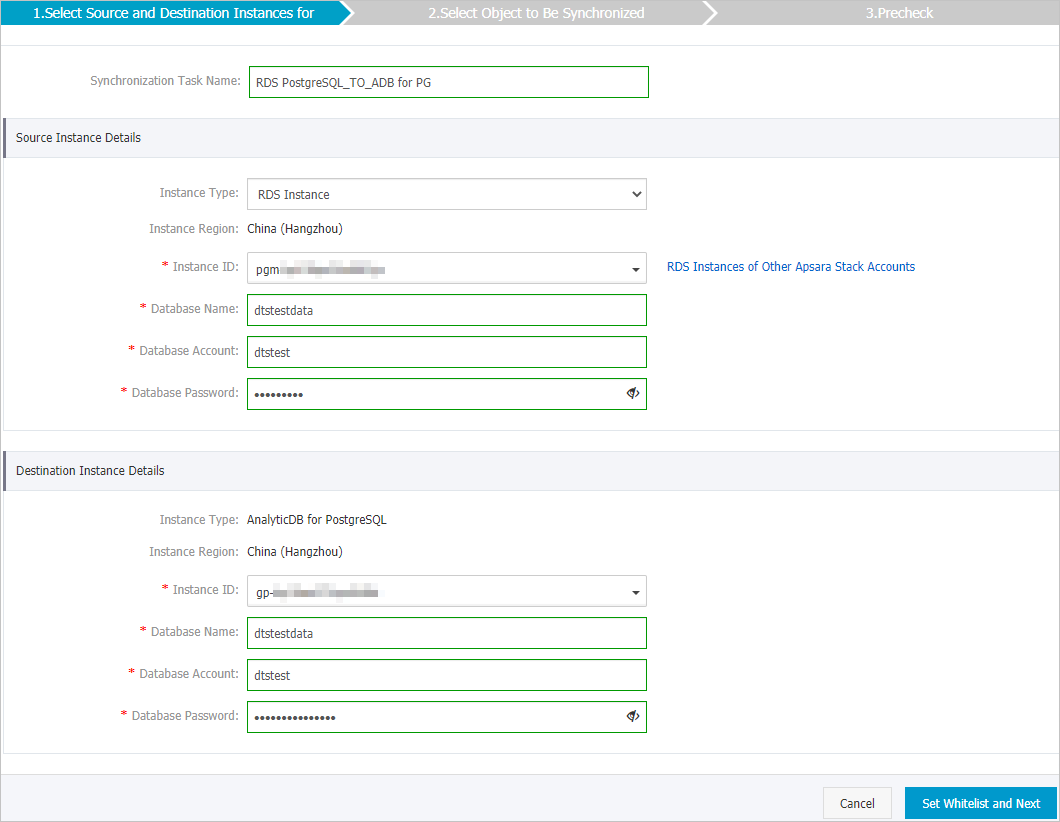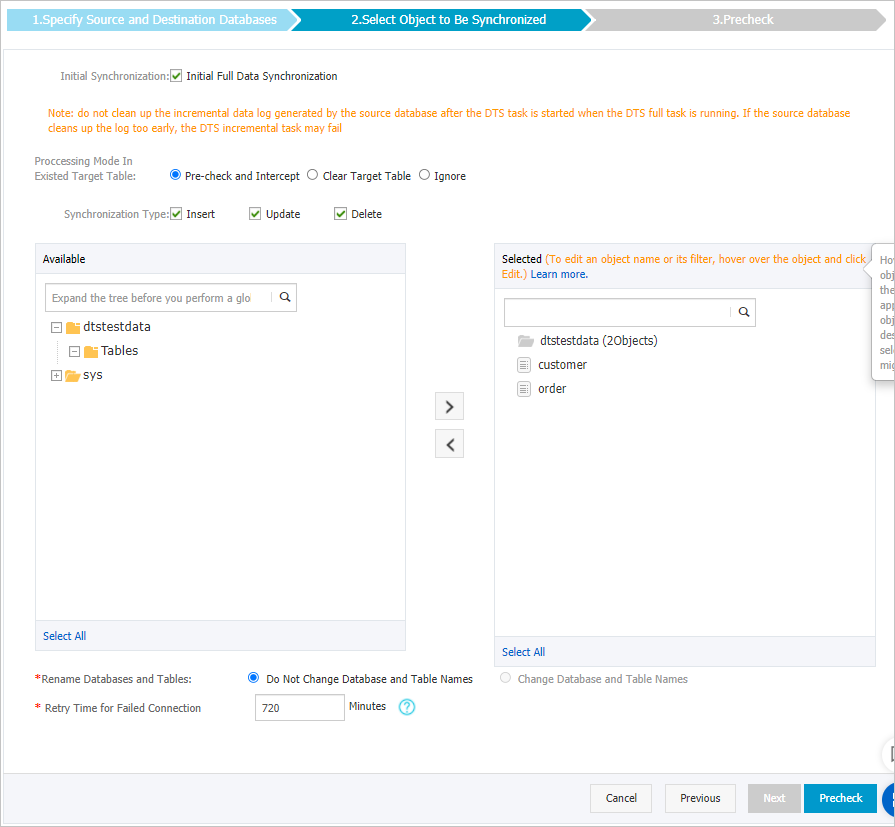This topic describes how to synchronize data from an ApsaraDB RDS for PostgreSQL instance to an AnalyticDB for PostgreSQL instance by using Data Transmission Service (DTS). The data synchronization feature provided by DTS allows you to transfer and analyze data with ease.
Prerequisites
The tables to be synchronized from the ApsaraDB RDS for PostgreSQL instance must contain primary keys.
The destination AnalyticDB for PostgreSQL instance is created. For more information, see Create an instance.
Usage notes
A data synchronization task can synchronize data from only one database. To synchronize data from multiple databases, you must create a data synchronization task for each database.
During data synchronization, new tables that are created in the source database can also be synchronized. However, to ensure data consistency, you must execute the following statement on the new tables before they can be synchronized:
ALTER TABLE schema.table REPLICA IDENTITY FULL;To ensure that the data synchronization task runs as expected, you can perform primary/secondary switchover only on an ApsaraDB RDS for PostgreSQL 11 instance. In this case, you must set the
rds_failover_slot_modeparameter tosync. For more information, see Logical Replication Slot Failover.WarningIf you perform primary/secondary switchover on a self-managed PostgreSQL database or an ApsaraDB RDS for PostgreSQL instance of other versions, the data synchronization task fails.
If one or more long-running transactions exist in the source database and incremental data is synchronized in the data synchronization task, the write-ahead logging (WAL) logs generated before the long-running transactions in the source database are committed may be accumulated. As a result, the disk space of the source database may be insufficient.
Billing
| Synchronization type | Task configuration fee |
| Schema synchronization and full data synchronization | Free of charge. |
| Incremental data synchronization | Charged. For more information, see Billing overview. |
Limits
Schema synchronization is not supported. DTS does not synchronize the schemas of objects from the source database to the destination database.
You can select only tables as the objects to be synchronized.
DTS does not synchronize the following types of data: BIT, VARBIT, GEOMETRY, UUID, TSQUERY, TSVECTOR, and TXID_SNAPSHOT.
If you perform a DDL operation on an object to be synchronized in the source database during data synchronization, you must perform the operation in the destination database. Then, you must restart the data synchronization task.
SQL operations that can be synchronized
INSERT, UPDATE, and DELETE
Preparations
Change the value of the
wal_levelparameter for the source ApsaraDB RDS instance.WarningAfter you change the value of the
wal_levelparameter, you must restart the instance to apply the change. We recommend that you evaluate the impact on your business and change the parameter settings during off-peak hours.Log on to the ApsaraDB RDS console.
In the left-side navigation pane, click Instances.
In the top navigation bar, select the region in which the ApsaraDB RDS for PostgreSQL instance resides.
Find the ApsaraDB RDS for PostgreSQL instance and click the ID of the instance.
In the left-side navigation pane, click Parameters.
On the Parameters page, find the
wal_levelparameter and change the parameter value tological.NoteFor more information, see Modify the parameters of an ApsaraDB RDS for PostgreSQL instance.
Create a database, schema, and table in the destination AnalyticDB for PostgreSQL instance based on the schema of the objects to be synchronized. For more information, see SQL syntax.
Procedure
Purchase a data synchronization instance. For more information, see Purchase a DTS instance.
NoteOn the buy page, set Source Instance to PostgreSQL, set Destination Instance to AnalyticDB for PostgreSQL, and set Synchronization Topology to One-Way Synchronization.
Log on to the DTS console.
NoteIf you are navigated to the Data Management (DMS) console from the DTS console, you can move the pointer over the
 icon in the lower-right corner and click the
icon in the lower-right corner and click the  icon to return to the DTS console.
icon to return to the DTS console. If you are navigated to the DTS console of the new version, you can click the
 icon in the lower-right corner to go to the DTS console of the previous version.
icon in the lower-right corner to go to the DTS console of the previous version.
In the left-side navigation pane, click Data Synchronization.
In the upper part of the Synchronization Tasks page, select the region in which the destination instance resides.
Find the data synchronization instance and click Configure Task in the Actions column.
Configure the source and destination instances.

Section
Parameter
Description
N/A
Synchronization Task Name
The task name that DTS automatically generates. We recommend that you specify a descriptive name that makes it easy to identify the task. You do not need to use a unique task name.
Source Instance Details
Instance Type
The instance type of the source database. Select RDS Instance.
Instance Region
The source region that you selected on the buy page. You cannot change the value of this parameter.
Instance ID
The ID of the ApsaraDB RDS for PostgreSQL instance.
Database Name
The name of the source database.
Database Account
The privileged account of the ApsaraDB RDS for PostgreSQL instance. The account must be the owner of the selected database.
NoteIf the source database runs on an ApsaraDB RDS for PostgreSQL 9.4 instance and you synchronize only DML operations, only the REPLICATION permission is required for the database account.
Database Password
The password of the database account.
Destination Instance Details
Instance Type
The value of this parameter is fixed to AnalyticDB for PostgreSQL.
Instance Region
The destination region that you selected on the buy page. You cannot change the value of this parameter.
Instance ID
The ID of the destination AnalyticDB for PostgreSQL instance.
Database Name
The name of the destination database.
NoteThe database must exist in the AnalyticDB for PostgreSQL instance. Otherwise, you must Manage databases.
Database Account
The initial account of the AnalyticDB for PostgreSQL instance. For more information, see Create a database account.
NoteYou can also enter an account that has the RDS_SUPERUSER permission. For more information, see Manage users and permissions.
Database Password
The password of the database account.
In the lower-right corner of the page, click Set Whitelist and Next.
If the source or destination database is an Alibaba Cloud database instance, such as an ApsaraDB RDS for MySQL or ApsaraDB for MongoDB instance, DTS automatically adds the CIDR blocks of DTS servers to the IP address whitelist of the instance. If the source or destination database is a self-managed database hosted on an Elastic Compute Service (ECS) instance, DTS automatically adds the CIDR blocks of DTS servers to the security group rules of the ECS instance, and you must make sure that the ECS instance can access the database. If the self-managed database is hosted on multiple ECS instances, you must manually add the CIDR blocks of DTS servers to the security group rules of each ECS instance. If the source or destination database is a self-managed database that is deployed in a data center or provided by a third-party cloud service provider, you must manually add the CIDR blocks of DTS servers to the IP address whitelist of the database to allow DTS to access the database. For more information, see Add the CIDR blocks of DTS servers.
WarningIf the CIDR blocks of DTS servers are automatically or manually added to the whitelist of the database or instance, or to the ECS security group rules, security risks may arise. Therefore, before you use DTS to synchronize data, you must understand and acknowledge the potential risks and take preventive measures, including but not limited to the following measures: enhancing the security of your username and password, limiting the ports that are exposed, authenticating API calls, regularly checking the whitelist or ECS security group rules and forbidding unauthorized CIDR blocks, or connecting the database to DTS by using Express Connect, VPN Gateway, or Smart Access Gateway.
Configure the synchronization policy and the objects to be synchronized.

Section
Parameter
Description
Set the synchronization policy
Initialize Synchronization
By default, Initial Full Data Synchronization is selected. After the precheck, DTS synchronizes historical data of the required objects from the source database to the destination instance. The data is the basis for subsequent incremental synchronization.
Processing Mode of Conflicting Tables
Clear Data
Skip the check for empty destination tables during the precheck. Clear the data in destination tables before the full data synchronization task is initialized. If you want to synchronize your business data after testing the data synchronization task, you can select this mode.
Ignore
Skips the check for empty destination tables during the precheck. Add data to the existing data during initial full data synchronization. If you want to synchronize data from multiple tables to one table, you can select this mode.
Synchronization Type
Select the types of operations that you want to synchronize based on your business requirements.
NoteThe Alter Table operation is not supported.
Insert
Update
Delete
AlterTable
Select the objects to be synchronized
N/A
Select one or more tables from the Available section and click the
 icon to add the tables to the Selected section. Note
icon to add the tables to the Selected section. NoteYou can select only tables as objects to be synchronized.
You can use the object name mapping feature to rename the columns that are synchronized to the destination database. For more information, see Rename an object to be synchronized.
Rename Databases and Tables
N/A
You can use the object name mapping feature to rename the objects that are synchronized to the destination instance. For more information, see Object name mapping.
Retry Time for Failed Connections
N/A
By default, if DTS fails to connect to the source or destination database, DTS retries within the next 720 minutes (12 hours). You can specify the retry time based on your needs. If DTS reconnects to the source and destination databases within the specified time, DTS resumes the data synchronization task. Otherwise, the data synchronization task fails.
NoteWhen DTS retries a connection, you are charged for the DTS instance. We recommend that you specify the retry time based on your business needs. You can also release the DTS instance at your earliest opportunity after the source and destination instances are released.
In the lower-right corner of the page, click Precheck.
NoteBefore you can start the data synchronization task, DTS performs a precheck. You can start the data synchronization task only after the task passes the precheck.
If the task fails to pass the precheck, you can click the
 icon next to each failed item to view details.
icon next to each failed item to view details. After you troubleshoot the issues based on the details, initiate a new precheck.
If you do not need to troubleshoot the issues, ignore the failed items and initiate a new precheck.
Close the Precheck dialog box after the following message is displayed: Precheck Passed. Then, the data synchronization task starts.
Wait until initial synchronization is complete and the data synchronization task enters the Synchronizing state.
You can view the status of the data synchronization task on the Synchronization Tasks page.
